In Furness and the Cumbrian Coast (Part 1), I described my travels as far as Whitehaven Bransty on what's now marketed as the Cumbrian Coast Line. There's a Wikipedia article here.
Whitehaven
I arrived at Whitehaven Bransty around 12:39 with the weather still hot. This was a modern station with one through platform which I'd just arrived on and one empty Bay platform. I left the station and looked down the hill. A short walk would take me to the harbour but I could see that it had been modernised into a boat marina. On my right sat a large Tesco store. Knowing that there was a train north at 12:54, I decided to defer my exploration of Whitehaven to another trip and returned to study the station.
The driver of the 2-car diesel multiple unit I'd arrived on was 'changing ends' prior to forming the 12:54 back to Lancaster. The driver had unlocked a Token Cupboard on the platform and was working the electric token machine whilst talking to the signalman on the telephone. After he'd extracted the token which authorised him to travel on the single line back to St. Bees, the signalman cleared the 2-aspect modern colour-light signal from red to green.
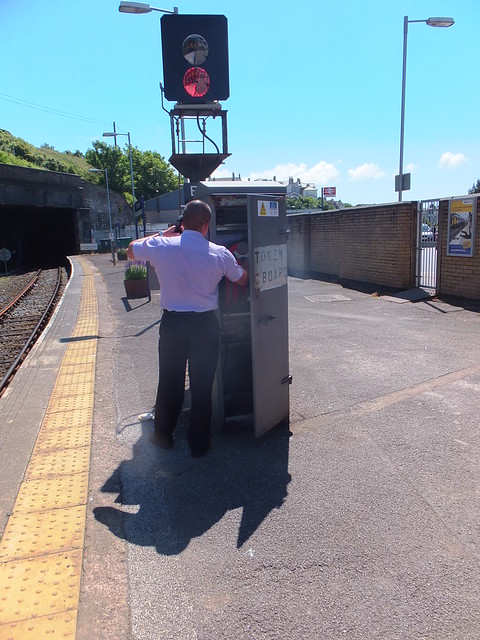
Whitehaven through platform, looking south towards the tunnel mouth. The driver is extracting the single line token.
There were a number of passengers waiting in the sun so it was clear that another train was due and, after a few minutes, a Class 156 2-car diesel multiple unit appeared from the north and rolled into the bay platform. After the arriving passengers had left the train, the waiting passengers clambered in. The step-up from platform to train on the bay platform was quite large and there was a yellow-painted set of wooden steps on the platform to assist. There were four doors on the side of the train and only one set of steps so most people just had to manage the large step-up. Although there were at least two railway staff manning the modern booking office, I noticed that there was no member of staff on the platform to assist boarding passengers.
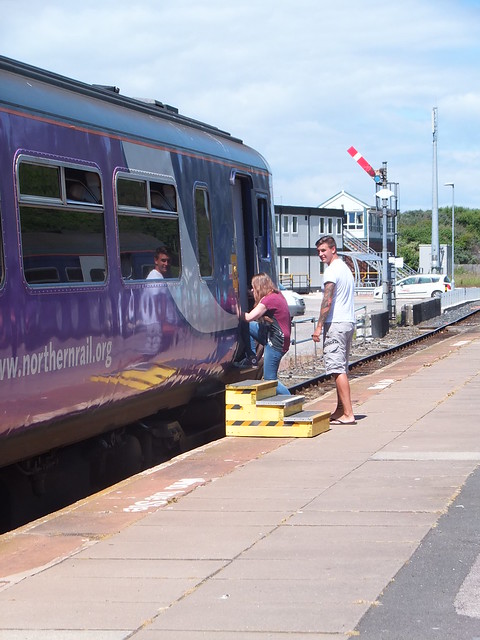
Passengers boarding the Carlisle train at Whitehaven.
On to Workington
We departed on time, passed the remaining signal box (formerly 'Whitehaven Bransty No. 2', now just labelled 'Bransty') and entered the double-track line which ran along the sea wall to our first station stop at Parton. Looking back, I could see the jetty at the approach to Whitehaven Harbour and, beyond, St. Bees Head.
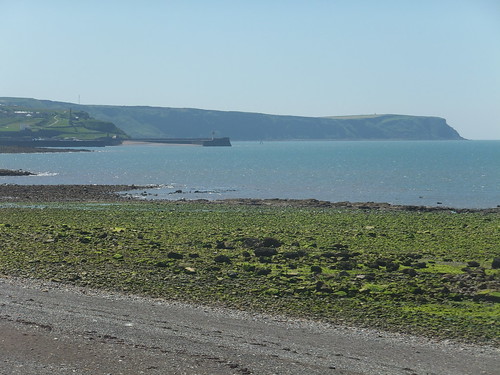 View of Whitehaven and St. Bees head from Parton.
View of Whitehaven and St. Bees head from Parton.
About 700 yards beyond Parton, the line singled. We continued for about 1400 yards on the single line, hugging the sea wall and then double track resumed. The track changes appeared fairly recent and the necessary points and signals seemed to be remotely controlled from Bransty. I assumed the alteration had been made because of problems with the 'shelf' on which the track is laid, squeezed between sea wall on our left and low cliffs on our right. We made a brief stop at Harrington then Workington was just two and a half miles away.
The line was still running close to the beach and I noticed a long row of vaguely pyramidal objects dotted along the head of the beach - dozens and dozens of them. They reminded me of the sort of concrete objects deployed on beaches in WWII to hamper invasion. The colour was too dark for concrete but then I realised - they were lumps of solidified steel-making slag and the shape was that of the slag ladle car which had transported the slag from the steelworks. Then, I was able to see the trackbed of what appeared to be a single siding running parallel to the beach. There were even a couple of small stone underbridges where the siding crossed footpaths.
I knew that steelmaking had ceased in Workington but, on my previous visit to Workington in the 1990s, I'd been impressed with the scale of the remaining rolling mills which specialised in the manufacture of railway rails. But, in 2014, little remains here except the double track main line. There's a most useful site which gives a good idea of Workington's industrial history here. Tata Steel Projects still have a presence in Workington (described on their website here) but, as recently as December 2013, another 75 jobs were lost locally.
The tangle of sidings and additional running lines has gone and signal boxes at Moss Bay Iron Works, Derwent Haematite Works, and Workington Main No. 1 have been abolished. Workington Main No. 2 signal box remains, heavily modified externally like virtually all the dwindling number of signal boxes remaining on Network Rail, as does Workington Main No. 3 signal box at the north end of the station.
 The long pedestrian footbridge shows where the sidings were: the bare yard shows where the mills once stood.
The long pedestrian footbridge shows where the sidings were: the bare yard shows where the mills once stood.
Workington Main station retains its two long platforms with quite nicely restored ranges of buildings on both platforms. With a service of only about one train an hour each way, I only saw one member of staff and he was in the booking office. But I was cheered that it at least looked like a railway station rather than a bus shelter.
 Workington: Station buildings on the Up Platform.
Workington: Station buildings on the Up Platform.
I'd a little under an hour to explore before there was another train northwards. Leaving the station, I decided to walk towards the sea. The River Derwent reaches its estuary in two channels. I followed the narrower one - a muddy creek with stone-built houses along the Town Quay with dozens of small boats waiting for the returning tide.
 The Town Quay at Workington.
The Town Quay at Workington.
The Port of Workington is a more modern enclosed dock (the Prince of Wales Dock) on the opposite side of the river. I took I different route to backtrack to the station, noting that part of the old steelworks site had been converted into a series of modern factory units. I then made my way towards the town centre along Station Street., with the Parish Church of St. Michael on my left.
 St. Michael's slumbers in the heat of the afternoon. One of the two women on the left enjoying the sun has donned a swimsuit!
St. Michael's slumbers in the heat of the afternoon. One of the two women on the left enjoying the sun has donned a swimsuit!
I passed a variety of shops and was tempted by a fish and chip shop, enjoying an excellent portion of chips served in a cardboard box, like a small pizza box. One detached stone building is now a sports injury clinic, but what caught my eye was the carefully-preserved signwriting on the end wall proclaiming 'OXFORD HOTEL TEMPERANCE LUNCHES AND TEAS'. I think the last line may have been the name of the proprietor, but I couldn't make it out. When I reached the small bus station, I retraced my route back to the station, in plenty of time to catch the 14:08 northbound service. Workington has a population of about 25,000 and I'd found the place far more appealing than I expected but the loss of jobs must have created ongoing problems. There's a Wikipedia article on the town here.
Maryport
I decided I'd make a stop at the smaller town of Maryport (population around 12,000) which I'd visited before and has always been something of a tourist destination. The 14:08 train from Workington took only eight minutes to reach Maryport. Although the line is double track, there's only one platform at Maryport (I think this was always so). I remembered the L.M.S. standard composite signal box from my earlier visit (now heavily modified, of course) but signals are now colour light and points are power operated. The station 'building' is a very upmarket bus shelter in wood and glass. For some reason, it looked Japanese to me.
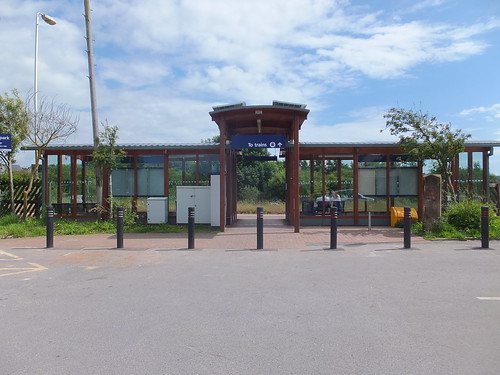 Maryport Station, viewed from the car park.
Maryport Station, viewed from the car park.
I set off for the harbour, knowing I had a little over an hour before there was a train onwards to Carlisle. The inevitable Station Street led me across the River Ellen and Curzon Street, busy with traffic. Then I walked through Mill Street car park and took an attractive footpath which led me to Senhouse Street - a main shopping street sloping down to the harbour. A fairly elaborate brick and stone frontage still proclaimed 'Empire Theatre' and, in a laurel wreath, the build date (1911, I think).The building has now been converted into two shops. Another shop building (currently empty) still had the signwriting "Ogni's Ices" on the end wall - I assumed the Ognis were Italians for Italians were widely involved in popularising ice cream in England.
I passed the 'White Star Pub'. I discovered that Thomas Henry Ismay (1837 - 1899) was born in a cottage at Maryport and went on to run the White Star Line. His son Joseph Bruce Ismay (1862 - 1937) is known for surviving the maiden voyage of the 'Titanic'.
I found the harbour area very attractive. Having purchased an ice cream, I walked around the nearer harbour, used by a number of fishing boats. I didn't go to the further harbour, which appeared to be another marina for pleasure craft. There were certainly tourists about but it wasn't crowded. I decided it was time to return to the station (I was certainly getting tired with all the walking).
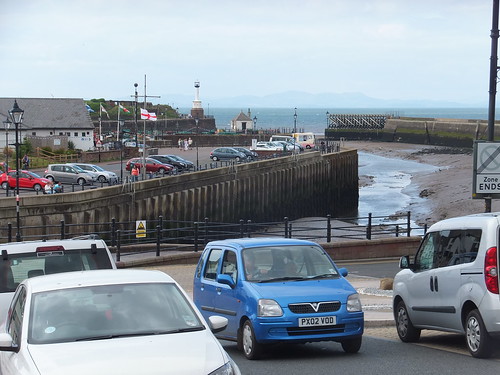 Maryport Harbour.
Maryport Harbour.
Returning up Senhouse Street, I noticed a residential side street temporarily closed to traffic because of excavations in the road. One of the houses in the street had brought folding chairs out onto the pavement and a family of eleven, including children, were having a picnic and soaking up the sun!
 An unusual venue for a picnic in Maryport.
An unusual venue for a picnic in Maryport.
On to Carlisle
Back at Maryport station, I boarded a stopping train for Carlisle. When we stopped at Wigton station, I spotted a marvellous old photograph of the original stone station building, complete with its row of Ionic Order columns on the platform side.
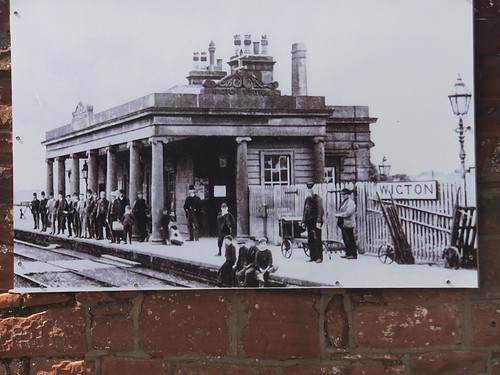 A marvellous photograph of the original Wigton Station Building, displayed on today's more modest station.
A marvellous photograph of the original Wigton Station Building, displayed on today's more modest station.
Whilst railway architects have often provided impressive facades on the road approach side, the railway side is usually simpler and often hidden under platform roofing arrangements. I was reminded of the rather grand elevation on the railway side of the station at Delyatin, in Ukraine, which similarly featured Ionic Order columns.

Not Cumbria, but Delyatin station in Ukraine.
Approaching Carlisle we were routed into Bay 2 of this important station. I joined the throng of passengers and crossed the broad footbridge to the main Up Platform to study the possibilities for onward travel.
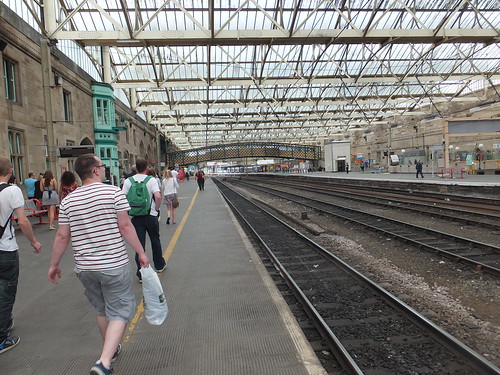 Carlisle Station, viewed from platform 3 showing the footbridge and overall roof.
Carlisle Station, viewed from platform 3 showing the footbridge and overall roof.
Virgin operate a frequent service of 'Pendolino' trains between Glasgow/Edinburgh and London Euston. Some of these trains take the Trent Valley Line from Stafford to Rugby, others take the Stour Valley Line through Wolverhampton (my destination) and Birmingham New Street (offering a host of connections, particularly to the south-west). I decided to catch the next southbound service (which would take the Trent Valley Line) as far as Wigan where I would change to the following train which would deliver me to Wolverhampton.
This allowed time for a brief walk around Carlisle, with its population of around 72,000. The local government district is the City of Carlisle, bringing the population up to around 100,000. After a brief foray into the city, I was quite tired and quite happy to return to return to the station for my chosen train.
The Journey Home
I didn't pay the usual attention as the 'Pendolino' sped south on the West Coast Main Line. We stopped at Penrith, Lancaster, Preston before I alighted at Wigan (North Western) to await the following train. I often pass through Wigan by train but don't often actually get off - this is why I'd chosen to change here. I mustered sufficient energy to leave the station and walk up the hill as far as the second station - Wigan (Wallgate). Back at Wigan (North Western), I explored a little but my camera battery finally gave up (I'd omitted to bring a spare) so I quietly waited for my train. Fortunately, the journey was uneventful so I arrived back home very tired but pleased with what I'd managed to fit in.
My pictures
General pictures
Cumbrian Coast Scenes.
Maryport, Cumbria
Railway pictures
Cumbrian Coast Line.
Whitehaven railways.
Workington Main station.
Maryport & Carlisle Railway.
Carlisle's Railways.
